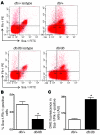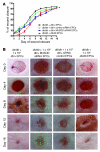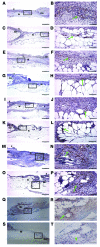Manganese superoxide dismutase expression in endothelial progenitor cells accelerates wound healing in diabetic mice
- PMID: 21060152
- PMCID: PMC2993576
- DOI: 10.1172/JCI36858
Manganese superoxide dismutase expression in endothelial progenitor cells accelerates wound healing in diabetic mice
Abstract
Amputation as a result of impaired wound healing is a serious complication of diabetes. Inadequate angiogenesis contributes to poor wound healing in diabetic patients. Endothelial progenitor cells (EPCs) normally augment angiogenesis and wound repair but are functionally impaired in diabetics. Here we report that decreased expression of manganese superoxide dismutase (MnSOD) in EPCs contributes to impaired would healing in a mouse model of type 2 diabetes. A decreased frequency of circulating EPCs was detected in type 2 diabetic (db/db) mice, and when isolated, these cells exhibited decreased expression and activity of MnSOD. Wound healing and angiogenesis were markedly delayed in diabetic mice compared with normal controls. For cell therapy, topical transplantation of EPCs onto excisional wounds in diabetic mice demonstrated that diabetic EPCs were less effective than normal EPCs at accelerating wound closure. Transplantation of diabetic EPCs after MnSOD gene therapy restored their ability to mediate angiogenesis and wound repair. Conversely, siRNA-mediated knockdown of MnSOD in normal EPCs reduced their activity in diabetic wound healing assays. Increasing the number of transplanted diabetic EPCs also improved the rate of wound closure. Our findings demonstrate that cell therapy using diabetic EPCs after ex vivo MnSOD gene transfer accelerates their ability to heal wounds in a mouse model of type 2 diabetes.
Figures










Similar articles
-
AMP-activated protein kinase rescues the angiogenic functions of endothelial progenitor cells via manganese superoxide dismutase induction in type 1 diabetes.Am J Physiol Endocrinol Metab. 2011 Jun;300(6):E1135-45. doi: 10.1152/ajpendo.00001.2011. Epub 2011 Mar 22. Am J Physiol Endocrinol Metab. 2011. PMID: 21427411 Free PMC article.
-
Curcumin reverses diabetes-induced endothelial progenitor cell dysfunction by enhancing MnSOD expression and activity in vitro and in vivo.J Tissue Eng Regen Med. 2018 Jul;12(7):1594-1607. doi: 10.1002/term.2684. Epub 2018 May 18. J Tissue Eng Regen Med. 2018. PMID: 29702753
-
Topical application of ex vivo expanded endothelial progenitor cells promotes vascularisation and wound healing in diabetic mice.Int Wound J. 2013 Oct;10(5):527-33. doi: 10.1111/j.1742-481X.2012.01010.x. Epub 2012 Jun 28. Int Wound J. 2013. PMID: 22738265 Free PMC article.
-
Endothelial progenitor cell therapy for chronic wound tissue regeneration.Cytotherapy. 2019 Nov;21(11):1137-1150. doi: 10.1016/j.jcyt.2019.09.002. Epub 2019 Oct 23. Cytotherapy. 2019. PMID: 31668487 Review.
-
Hyperoxia, endothelial progenitor cell mobilization, and diabetic wound healing.Antioxid Redox Signal. 2008 Nov;10(11):1869-82. doi: 10.1089/ars.2008.2121. Antioxid Redox Signal. 2008. PMID: 18627349 Free PMC article. Review.
Cited by
-
Trace Amounts of Copper in Drinking Water Aggravate Cerebral Ischemic Injury via Impairing Endothelial Progenitor Cells in Mice.CNS Neurosci Ther. 2015 Aug;21(8):677-80. doi: 10.1111/cns.12427. CNS Neurosci Ther. 2015. PMID: 26197838 Free PMC article. No abstract available.
-
Angioblast Derived from ES Cells Construct Blood Vessels and Ameliorate Diabetic Polyneuropathy in Mice.J Diabetes Res. 2015;2015:257230. doi: 10.1155/2015/257230. Epub 2015 Apr 21. J Diabetes Res. 2015. PMID: 25977928 Free PMC article.
-
Piezo1 mediates angiogenesis through activation of MT1-MMP signaling.Am J Physiol Cell Physiol. 2019 Jan 1;316(1):C92-C103. doi: 10.1152/ajpcell.00346.2018. Epub 2018 Nov 14. Am J Physiol Cell Physiol. 2019. PMID: 30427721 Free PMC article.
-
Low-Dose Piperlongumine Rescues Impaired Function of Endothelial Progenitor Cells and Reduces Cerebral Ischemic Injury in High-Fat Diet-Fed Mice.Front Pharmacol. 2021 Nov 15;12:689880. doi: 10.3389/fphar.2021.689880. eCollection 2021. Front Pharmacol. 2021. PMID: 34867315 Free PMC article.
-
Autologous circulating angiogenic cells treated with osteopontin and delivered via a collagen scaffold enhance wound healing in the alloxan-induced diabetic rabbit ear ulcer model.Stem Cell Res Ther. 2013;4(6):158. doi: 10.1186/scrt388. Stem Cell Res Ther. 2013. PMID: 24444259 Free PMC article.
References
-
- Brem H, Sheehan P, Rosenberg HJ, Schneider JS, Boulton AJ. Evidence-based protocol for diabetic foot ulcers. Plast Reconstr Surg. 2006;117(7 suppl):193S–209S. - PubMed
-
- Loomans CJ, et al. Endothelial progenitor cell dysfunction: a novel concept in the pathogenesis of vascular complications of type 1 diabetes. Diabetes. 2004;53(1):195–199. - PubMed
Publication types
MeSH terms
Substances
Grants and funding
LinkOut - more resources
Full Text Sources
Other Literature Sources
Medical
Molecular Biology Databases
Miscellaneous

